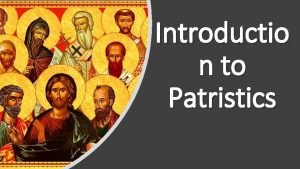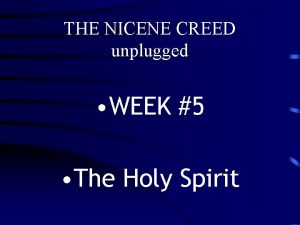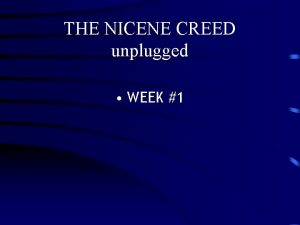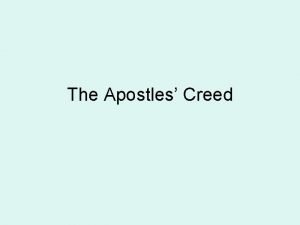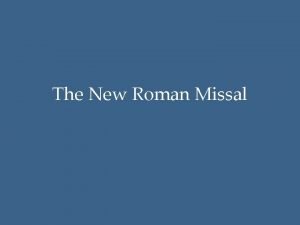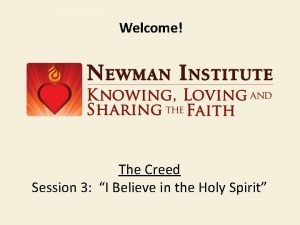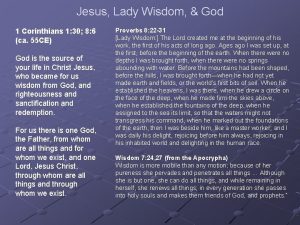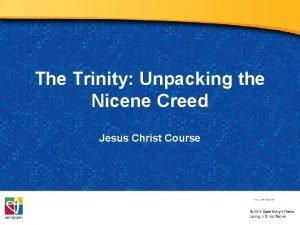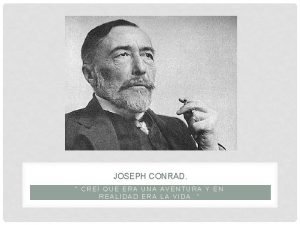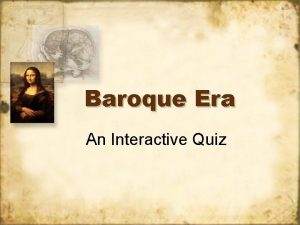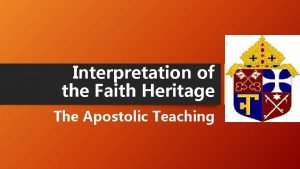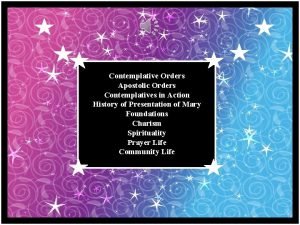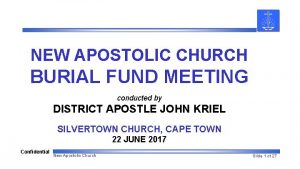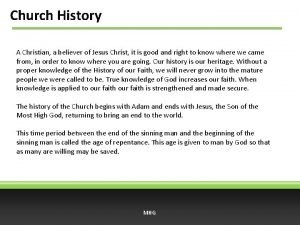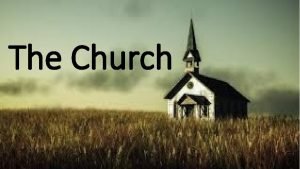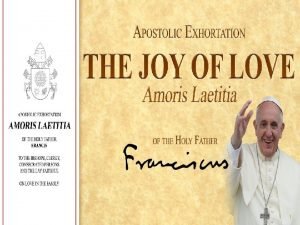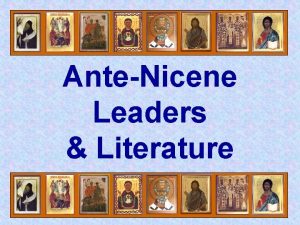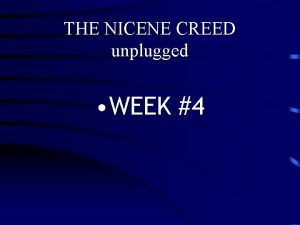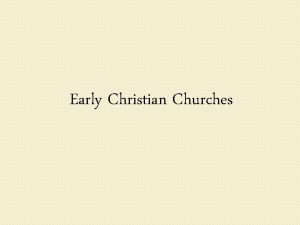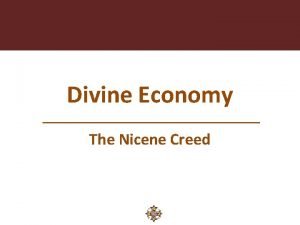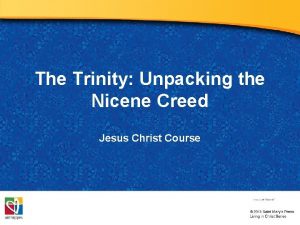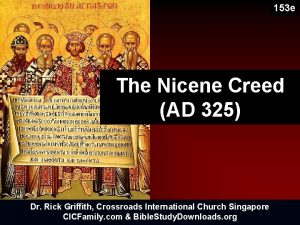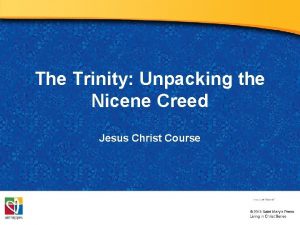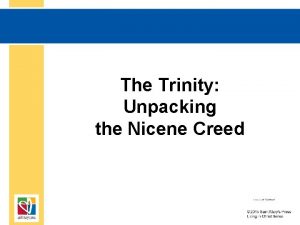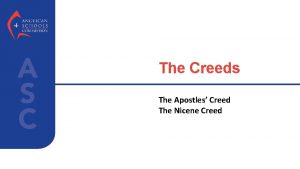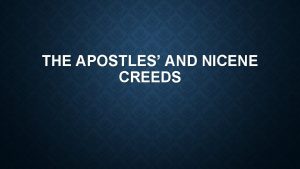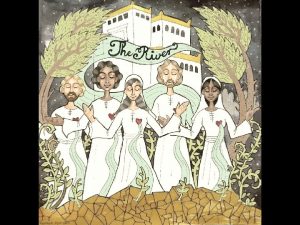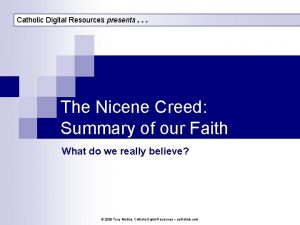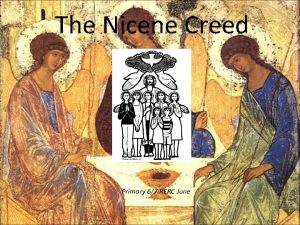Introductio n to Patristics Apostolic Era Ante Nicene



















- Slides: 19

Introductio n to Patristics


Apostolic Era Ante Nicene Fathers Post Nicene Fathers

The Didache (διδαχή) • The full title is: Διδαχὴ Κυρίου διὰ τῶν δώδεκα ἀποστόλων τοῖς ἔθνεσιν • (The Lord's Teaching Through the Twelve Apostles to the Nations) • Was commonly used as a form of catechism for those who decided to enter the faith • It is a document which clearly shows us the lived practice of the Christian faith in the 1 st century • Was not just directed towards Jews, but to the Gentiles also


What does the Didache Talk About? 1. Procedures of baptism 2. Rites and tradition of the Passover feast 3. Origins of fasting 4. Origins of prayer, and so on and so forth

“And concerning baptism, baptize this way: Having first said all these things, baptize into the name of the Father, and of the Son, and of the Holy Spirit, in living water. ” -Didache 7: 1

Fasting: “But let not your fasts be with the hypocrites (pharisees), for they fast on the second and fifth day of the week (Monday and Thursday). Rather, fast on the fourth day (Wednesday) and the preparation (Friday). ” - Didache 8: 1

Ante-Nicene Fathers: Ignatius of Antioch • Also known as Ιγνάτιος ὁ Θεοφόρος which means “the God bearing” • Lived from 35 – 107 AD • Death by martyrdom • “Let my spirit be counted as nothing for the sake of the cross, which is a stumbling-block to those that do not believe, but to us salvation and life eternal. ” • - Letter to the Ephesians, chapter 18.

Ignatius’ 7 epistles: 1. The Epistle to the Ephesians, Ephesians 2. The Epistle to the Magnesians, 3. The Epistle to the Trallians, 4. The Epistle to the Romans, Romans 5. The Epistle to the Philadelphians, 6. The Epistle to the Smyrnaeans, 7. The Epistle to Polycarp, a bishop of Smyrna.

“There is one Physician who is possessed both of flesh and spirit; both made and not made; God existing in flesh; true life in death; both of Mary and of God; first passible and then impassible, even Jesus Christ our Lord. ” - Letter to the Ephesians, chapter 7

Ante-Nicene Fathers part 2: Irenaeus of Lyon • A Greek bishop, well known for guiding and expanding Christian communities around what we know to be south France • Lived from 130 – 202 AD

Against heresies: • One of Irenaeus’ popular writings is his defense against Gnosticism, which was the belief that there was a good and bad God. The bad God was the one who created the materialistic world (often referred to in the old testament). And in order to be saved, one had to had a special knowledge called γνῶσις (Greek for knowledge, gnosis) • Jesus Christ, the son of God, was then sent to free us from the material world created by the evil God

“When we stand in the light it is not we who illumine the light and cause it to shine but we are illuminated and made shining by the light. . . God grants his blessings on those who serve him because they are serving him and on those who follow him because they are following him. ” - Irenaeus of Lyon, against the heresies

Athanasius the Apostolic: • I am aware that many of you are quite familiar with this name and his timeframe: just a quick overview: 1. ��������� or ����� �λεξανδρείας, 20 th pope 2. Lived from 296 -373 AD 3. Well known for his defense against Arianism as he was one of the prominent defenders among the 318 bishops who attend the council in Nicaea, 325. • Just as a side note: after the councils were held, Arianism didn’t vanish, it was still a very shaky situation in terms of political warfare!

The theology of Athanasius in his book against the followers of Arius: “But what is also to the point, let us note that the very tradition, teaching and faith of the Apostolic Church from the beginning, which the Lord gave, was preached by the Apostles, and was preserved by the Fathers. On this was the Church founded; and if anyone departs from this, he neither is nor any longer ought to be called a Christian: there is a Trinity holy and perfect, acknowledged as God, in Father, Son, and Holy Spirit, having nothing foreign or external mixed with It. ” - Athanasius the Apostolic, against the heathens

Cyril of Alexandria • �������� , 24 th pope (known as the pillar of faith) • Lived from 376 -444 • Well known for really 2 things mainly: 1. His defense against the heresies of Nestorius in the council of Ephesus at 431 AD 2. Developed and kept for us the original liturgy of saint mark the apostle, the first pope, with slightly extended texts necessary to further confirm orthodox trinitarian theology

“He who receives Communion is made holy and Divinized in soul and body in the same way that water, set over a fire, becomes boiling. . . Communion works like yeast that has been mixed into dough so that it leavens the whole mass; Just as by melting two candles together you get one piece of wax, so, I think, one who receives the Flesh and Blood of Jesus is fused together with Him by this Communion, and the soul finds that he is in Christ and Christ is in him. ” - Cyril of Alexandria, on the Holy Communion

Cappadocian Fathers: • Cappadocia today is located at the center region in Turkey (fun fact!) The 3 main Cappadocian Fathers are: • Basil the Great (bishop of Caesarea, lived during 329 – 379 A. D. ), one of his popular writings being on the Holy Spirit, wrote several anaphora's which are used not only in the Coptic orthodox church, but the byzantine orthodox as well • Gregory of Nyssa, a dear friend and brother of Basil (bishop of Nyssa, lived during 335 -395 A. D. ) Has many treatises, including teachings also on the Holy Spirit, directed to the followers of Macedonius (a form of sub-Arianism which led to the council of Constantinople at 381) • Gregory Nazianzus (archbishop of Constantinople, lived during 329 -390 A. D. ). Also known as Gregory theologian, he is the one who wrote the Gregorian liturgy which although is longer, is another liturgy commonly utilized in the Coptic orthodox church
 Ante nicene creed
Ante nicene creed Original nicene creed
Original nicene creed Creed unplugged
Creed unplugged Nicene creed catholic
Nicene creed catholic Baptismal creed
Baptismal creed New roman missal
New roman missal What is difference between apostles creed and nicene creed?
What is difference between apostles creed and nicene creed? Original nicene creed
Original nicene creed Trinity nicene creed
Trinity nicene creed Elizabethan or victorian
Elizabethan or victorian Creí que era una aventura y en realidad era la vida
Creí que era una aventura y en realidad era la vida Era uma estrela tão alta era uma estrela tão fria
Era uma estrela tão alta era uma estrela tão fria Quiz 2 the baroque era
Quiz 2 the baroque era What are the interpretation of the heritage of the faith
What are the interpretation of the heritage of the faith Apostolic orders
Apostolic orders New apostolic burial fund
New apostolic burial fund Apostolic age timeline
Apostolic age timeline Jesus answered
Jesus answered Apostolic background
Apostolic background Nac burial fund
Nac burial fund
